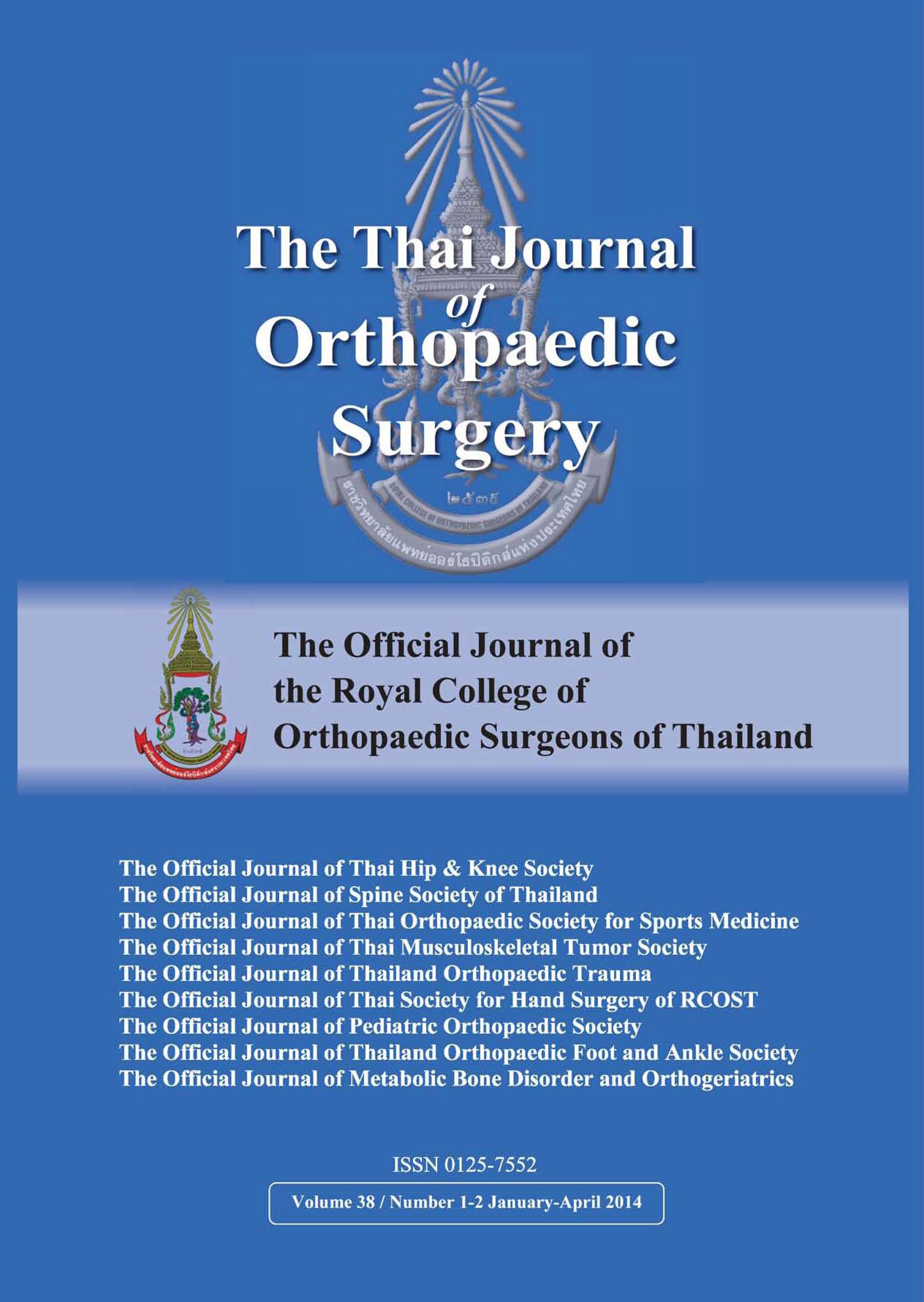Mid-term Result of Total Knee Arthroplasty in the Young Osteoarthritis Patients
Main Article Content
Abstract
Background: The primary goals of total knee arthroplasty (TKA) are to relieve pain and improve function in inflammatory and degenerative knee arthritis. Long-term clinical success has been shown in elderly patients.
Objective: The purpose of this study was to evaluate the clinical and radiographic results of TKA in patients with advanced stage osteoarthritis of the knee joints where the patients were younger than fifty-five years of age at the time of operation.
Materials and methods: The authors retrospectively reviewed the results of 70 patients with osteoarthritis who were 55 years or younger (mean age, 52.2 years) and who had received a fixed-bearing cemented TKA prosthesis and patellar resurfacing. The patients were assessed with regard to clinical, radiographic and knee motion assessment . Kaplan-Meier analysis of implant survival was performed.
Results: The mean preoperative and postoperative knee motion was 97.0° and 119.8°, respectively (P < 0.01). At the latest follow-up, Knee Society knee clinical scores improved from 45.6 to 83.3 points (P < 0.01) and Knee Society knee functional scores improved from 45.9 to 72.6 points (P < 0.01). There were three revision TKA that included aseptic loosening for two knees and septic loosening for one knee. The mean follow-up was 8.7 years (range, 5.0-16.0). The Kaplan-Meier survivorship analysis of implants showed that the rate of survival was 97.9% (95% CI, 90 to 99) at 10 years postoperatively and 96.9% (95% CI, 80 to 98) at 15 years postoperatively when revision was defined as the end point.
Discussion: The study showed improvement of functional and clinical knee scores at mid-term follow-up in patients with advanced stage osteoarthritis of the knee where the patients were younger than fifty-five years of age. However, there is concern in the findings of previous literature regarding the success of TKA in young patients. It will be important to determine the functional outcome and ability to return to an active lifestyle in younger patients. Long-term follow-ups in the second decade should be performed because younger patients will likely live long enough to require revision surgery.
Article Details
References
2. Pagnano MW, Levy BA, Berry DJ. Cemented all polyethylene tibial components in patients age 75 years and older. Clin Orthop Relat Res 1999; 367: 73-80.
3. Ritter MA. The Anatomical Graduated Component total knee replacement: a long-term evaluation with 20-year survival analysis. J Bone Joint Surg Br 2009; 91: 745-9.
4. Ewald F, Christie MJ. Results of cemented total knee replacement in young patients. Orthop Trans 1987; 11: 442.
5. W-Dahl A, Robertsson O, Lidgren L. Surgery for knee osteoarthritis in younger patients. Acta Orthop 2010; 81: 161-4.
6. Crowder AR, Duffy GP, Trousdale RT. Long-term results of total knee arthroplasty in young patients with rheumatoid arthritis. J Arthroplasty 2005; 20: 12-6.
7. Duffy GP, Trousdale RT, Stuart MJ. Total knee arthroplasty in patients 55 years old or younger. 10- to 17-year results. Clin Orthop Relat Res 1998; 356: 22-7.
8. Stern SH, Bowen MK, Insall JN, Scuderi GR. Cemented total knee arthroplasty for gonarthrosis in patients 55 years old or younger. Clin Orthop Relat Res 1990; 260: 124-9.
9. Keeney JA, Eunice S, Pashos G, Wright RW, Clohisy JC. What is the evidence for total knee arthroplasty in young patients?: a systematic review of the literature. Clin Orthop Relat Res 2011; 469: 574-83.
10. Ranawat CS, Padgett DE, Ohashi Y. Total knee arthroplasty for patients younger than 55 years. Clin Orthop Relat Res 1989; 248: 27-33.
11. Ranawat AS, Mohanty SS, Goldsmith SE, Rasquinha VJ, Rodriguez JA, Ranawat CS. Experience with an all-polyethylene total knee arthroplasty in younger, active patients with follow-up from 2 to 11 years. J Arthroplasty 2005; 20: 7-11.
12. Ewald FC. The Knee Society total knee arthroplasty roentgenographic evaluation and scoring system. Clin Orthop Relat Res 1989; 248: 9-12.
13. Segawa H, Tsukayama DT, Kyle RF, et al. Infection after total knee arthroplasty: a retrospective study of the treatment of eighty - one infections. J Bone Joint Surg Am 1999; 81: 1434-45.
14. Kurtz SM, Lau E, Ong K, Zhao K, Kelly M, Bozic KJ. Future young patient demand for primary and revision joint replacement: national projections from 2010 to 2030. Clin Orthop Relat Res 2009; 467: 2606-12.
15. Diduch DR, Insall JN, Scott WN, Scuderi GR, Font-Rodriguez D. Total knee replacement in young, active patients. Long-term follow-up and functional outcome. J Bone Joint Surg Am 1997; 79: 575-82.
16. Dalury DF, Ewald FC, Christie MJ, Scott RD. Total knee arthroplasty in a group of patients less than 45 years of age. J Arthroplasty 1995; 10: 598-602.
17. Lonner JH, Hershman S, Mont M, Lotke PA. Total knee arthroplasty in patients 40 years of age and younger with osteoarthritis. Clin Orthop Relat Res 2000; 380: 85-90.
18. Dixon MC, Brown RR, Parsch D, Scott RD. Modular fixed-bearing total knee arthroplasty with retention of the posterior cruciate ligament. A study of patients followed for a minimum of fifteen years. J Bone Joint Surg Am 2005; 87: 598-603.


